Lakhmir Singh & Manjit Kaur: The Human Eyes And The Colorful World, Solutions- 4 | Science Class 10 PDF Download
Page No:284
Question 5: Fill in the following blanks with suitable words :
(a) Having two eyes gives a…………. field of view.
(b) Having two eyes enables us to judge………….. more accurately.
Solution : (a) wider
(b) distances
Question 6: What are the advantages of having two eyes instead of just one ?
Solution : Following are the advantages of having two eyes instead of one:
1. Having two eyes gives a wider field of view.
2. Having two eyes enables us to judge distances more accurately.
Question 7: Explain clearly why, a person who has lost the sight of one eye is at a disadvantage compared with the normal person who has two good eyes.
Solution : A person who has lost the sight of one eye has a narrower field of view than the normal person who has two good eyes. Also, the person with one eye cannot judge distances accurately.
Question 8: Name two animals having eyes :
(a) on the sides of the head.
(b) at the front of the head.
Solution : (a) Rabbit, deer
(b) Tiger, lion
Question 9: Among animals, the predators (like lions) have their eyes facing forward at the front of their heads, whereas the animals of prey (like rabbit) usually have eyes at the sides of their head. Why is this so ?
Solution : The predators (like lions) have their eyes facing forward at the front of their heads, whereas the animals of prey (like rabbit) usually have eyes at the sides of their head so that they can see their enemies (predators) in a very large area around them and try to escape from them.
Question 10: Five persons A, B, C, D and E have diabetes, leukaemia, asthma, meningitis and hepatitis, respectively.
(a) Which of these persons can donate eyes ?
(b) Which of these persons cannot donate eyes ?
Solution : (a) A and C
(b) B, D and E
Page No:288
Question 1: As light rays pass from air into a glass prism, are they refracted towards or away from the normal ?
Solution : Towards the normal
Question 2: As light rays emerge from a glass prism into air, are they refracted towards or away from the normal ?
Solution : Away from the normal
Question 3: Name a natural phenomenon which is caused by the dispersion of sunlight in the sky.
Solution : Rainbow
Question 4: What information do we get about sunlight from the formation of a rainbow ?
Solution : Sunlight consists of seven colours.
Question 5: What did Newton demonstrate by his experiments with the prism ?
Solution : Newton demonstrated by his experiments with the prisms that white light consists of a mixture of seven colours.
Question 6: What colours make up white light ?
Solution : Seven colours – Violet, indigo, blue, green, yellow, orange, red
Question 7: Give the meaning of the term VIBGYOR. With which phenomenon is it connected ?
Solution : The seven colours of the spectrum of white light are denited by the word VIBGYOR where V stands for Violet, I for Indigo, B for Blue, G for Green, Y for Yellow, O for Orange and R for Red.
It is connected with the phenomenon of dispersion of light.
Question 8: In the formation of spectrum of white light by a prism :
- which colour is deviated least ?
- which colour is deviated most ?
Solution :
- Red
- Violet
Question 9: What colours lie on the two sides of the ‘green colour’ in the spectrum of white light ?
Solution : Yellow and Blue
Question 10: Name the scientist who discovered that sunlight consists of seven colours.
Solution : Newton
Question 11: What is the order of colours in a rainbow, from the outside to the inside ?
Solution : Red, Orange, Yellow, Green, Blue, Indigo and Violet
Question 12: Which colour of the spectrum has (a) longest wavelength, and (b) shortest wavelength ?
Solution : (a) Red
(b) Violet
Question 13: Which light has the longer wavelength : red light or blue light ?
Solution : Red Light
Question 14: Which colour of light has the shorter wavelength – red or violet ?
Solution : Violet
Question 15: Fill in the blanks with suitable words :
(a) When a ray of light enters a prism, it bends…………. ..the normal; as it leaves the prism, it bends…………..
the normal.
(b) White light is composed of…………I The colour of white light deviated through the largest angle by
a prism is………..
Solution : (a) towards, away from
(b) seven, violet
Question 16:
- A ray of white light breaks up into its components while passing through a glass prism.
Draw a ray diagram to show the path of rays. - Mark the least deviated colour in your diagram.
- Why do different coloured rays deviate differently in a prism ?
Solution :
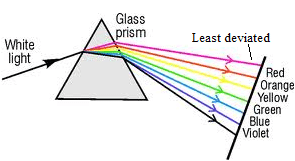
3. Different coloured rays deviate differently in a prism because different colours travel at different speeds through the glass prism.
Question 17: (a) What happens when a ray of ordinary light is passed through a triangular glass prism ?
(b) What will happen if another similar glass prism is placed upside down behind the first prism ?
Solution : (a) When a ray of ordinary light is passed through a triangular glass prism, it splits to form a band of seven colours.
(b) If another similar glass prism is placed upside down behind the first prism, then the seven coloured rays from the first prism which are incident on the second prism recombine to form the original white beam.
Question 18: When a beam of white light is passed through a prism, it splits to form lights of seven colours. Is it possible to recombine the lights of seven colours to obtain the white light again ?
Solution : Yes, it is possible to recombine the lights of seven colours to obtain the white light again by placing another similar prism alongside the first one in the inverted position as shown below.
The first prism disperses the white light into seven coloured rays. the second prism receives all the seven coloured rays from the first prism and recombines them into original white light. This is because the refration produced by the second prism is equal and opposite to that produced by the first prism.
Question 19: (a) What is spectrum ? What is the name of glass shape used to produce a spectrum ?
(b) How many colours are there in a full spectrum of white light ? Write the various colours of spectrum in the order, starting with red.
Solution : (a) The band of seven colours formed on a white screen, when a beam of white light is passed through a glass prism is called spectrum of white light. A glass prism is used to produce a spectrum.
(b) There are seven colours in the spectrum of white light. The colours are Red, Orange, Yellow, Green, Blue, Indigo and Violet.
Question 20: What is meant by dispersion of white light ? Describe the formation of rainbow in the sky with the help of a diagram.
Solution : The splitting up of white light into seven colours on passing through a transparent medium like a glass prism is called dispersion of light.
Formation of rainbow:
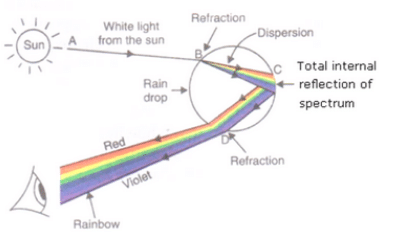
The raindrops act like small prisms. When sunlight enters and leaves these raindrops, the various coloured rays in white light are refracted by different amounts due to which an arc of seven colours called rainbow is formed.
Question 21: In the figure given alongside, a narrow beam of white light is shown to pass through a triangular glass prism. After passing through the prism, it produces a spectrum YX on the screen.
(a) State the colour seen (i) at X, and (ii) at Y.
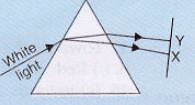
(b) Why do different colours of white light bend through different angles with respect to the incident beam of light ?
Solution : (a) (i) violet (ii) Red
(b) Different colours of white light bend through different angles because different colours travel through different speeds through in the glass prism.
Question 22: Draw a diagram to show how white light can be dispersed into a spectrum by using a glass prism. Mark the various colours of the spectrum.
Solution :
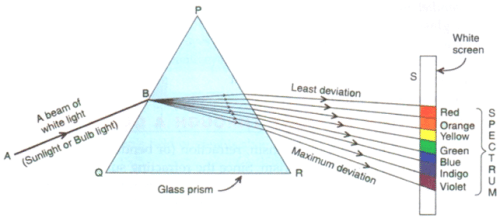
Question 23: Make two diagrams to explain refraction and dispersion.
Solution :
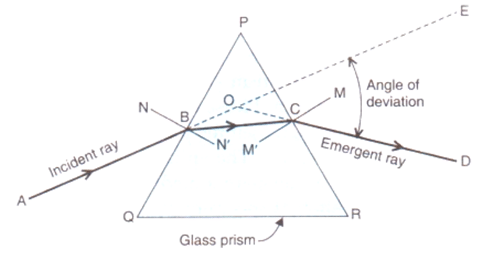

Question 23: Make two diagrams to explain refraction and dispersion.
Solution :
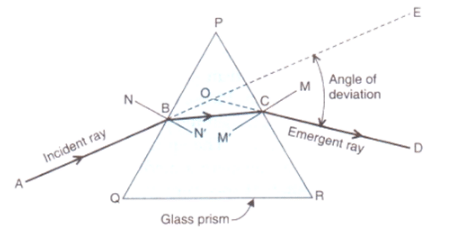
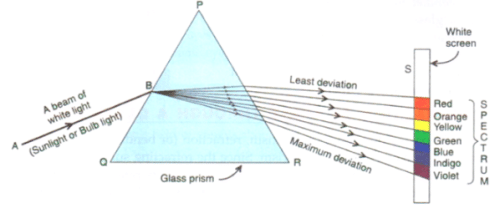
Question 24: Describe how you could demonstrate that white light is composed of a number of colours.
Solution : We will allow a beam of white light to pass through a glass prism. The white light splits to form a band of seven colours. This shows that white light is composed of seven colours.
Question 25: How could you show that the colours of the spectrum combine to give white light ?
Solution : Colours of a spectrum from one prism are allowed to fall on a similar prism placed adjacent to the first prism, but in inverted position. The refraction produced by second prism is equal and opposite to that produced by the first prism. This makes the colours of the spectrum combine to give white light.
Question 26: Which is refracted most by a prism : red light or violet light ? Explain why ?
Solution : Violet light is refracted the most because violet colour has the minimum speed in glass prism.
Question 27: (a)Draw a diagram to show the refraction of light through a glass prism. On this diagram, mark
- incident ray
- emergent ray, and
- angle of deviation.
(b) What is a rainbow ? What are the two conditions necessary for the formation of a rainbow in the sky ?
(c) What acts as tiny prisms in the formation of a rainbow ?
(d) Name the process which is involved in the formation of a rainbow.
(e) What are the seven colours seen in a rainbow ?
Solution :
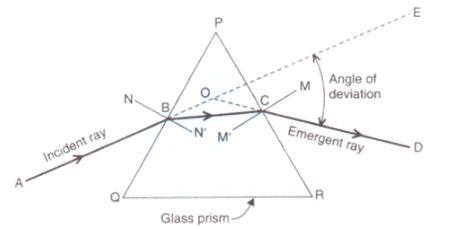
(b) Rainbow is an arch of seven colours visible in the sky which is produced by the dispersion of sun’s light by raindrops in the atmosphere. A rainbow is formed in the sky when the sun is shining and it is raining at the same time.
(c) Raindrops
(d) Dispersion of light
(e) Red, Orange, Yellow, Green, Blue, Indigo and Violet.
Page No:290
Question 38: Why do you not see a spectrum of colours when light passes through a flat pane of glass ?
Solution : Because a flat pane of glass has parallel sides.
Question 39: Name some everyday objects :
(a) which reflect all the colours in sunlight
(b) which absorb all the colours in sunlight
Solution : (a) White Paper
(b) Blackboard
Question 40: Where in nature can you find evidence that white sunlight may be made of different colours ?
Solution : Formation of the rainbow in the sky
Page No:292
Question 1: Name the phenomenon which causes the twinkling of stars.
Solution : Atmospheric refraction of light
Question 2: Name two effects produced by the atmospheric refraction.
Solution : Twinkling of stars; Advance sunrise and delayed sunset
Question 3: Which phenomenon makes us see the sun :
(a) a few minutes before actual sunrise ?
(b) a few minutes after actual sunset ?
Solution : (a) Atmospheric refraction of sunlight
(b) Atmospheric refraction of sunlight
Question 4: Atmospheric refraction causes advance sunrise and delayed sunset. By how much time is :
(a) sunrise advanced ?
(b) sunset delayed ?
Solution : (a) About 2 minutes
(b) About 2 minutes
Question 5: State whether the following statement is true or false :
The planets twinkle at night due to atmospheric refraction of light.
Solution : False
Question 6: Name the phenomenon due to which the stars seem higher in the sky than they actually are.
Solution : Atmospheric refraction of light
Question 7: Fill in the following blanks with suitable words :
We can see the sun about……….. minutes before the actual sunrise and about…………. minutes after the actual
sunset because of atmospheric…………..
Solution : two, two, refraction
Question 8: Why do stars seem higher than they actually are ? Illustrate your answer with the help of a diagram.
Solution : Stars seem higher than they actually are because of atmospheric refraction of light coming from the star while passing through the successive denser layers of earth’s atmosphere.
Question 9: Explain why, the sun can be seen about two minutes before actual sunrise. Draw a diagram to illustrate your answer.
Solution : The sun can be seen about two minutes before actual sunrise because of atmospheric refraction of sun’s light as shown in the following diagram. When the sun is slightly below the horizon, then the sun’s light coming from less dense air to more dense air is refracred downwards as it passes through the atmosphere and the appears to be raised above the horizon.
Question 10: Explain why, if we look at objects through the hot air over a fire, the objects appear to be moving (or shaking) slightly.
Solution : The air just above the fire becomes hotter. This hotter air is optically rarer but the colder air further up is optically denser, so when we see the objects by the light coming from them through hot and cold air layers having different optical densities, then refraction of light takes place randomly due to which the objects appear to be moving slightly.
Question 11: (a) What is atmospheric refraction ? What causes atmospheric refraction ?
(b) Why do stars twinkle on a clear night ?
(c) Explain why, the planets do not twinkle at night.
Solution : (a) The refraction of light caused by the earth’s atmosphere is called atmospheric refraction. It is caused due to the varying optical densities of different layers of earth’s atmosphere.
(b) The light coming from a star undergoes atmospheric refraction due to varying optical densities of air at various altitudes. The continuously changing atmosphere refracts the light from the star by different amounts from one moment to the next. Thus, the star-light reaching our eyes increases and decreases continuously and the star appears to twinkle.
(c) Planets appear to be quite big to us and can be considered to be a collection of a very large number of point sources of light. The dimming effect produced by some of the point sources is nullified by brighter effect produced by some other point sources. Thus, the overall brightness remains the same and the planets do not appear to twinkle.
Page No:293
Question 20: We know that light refracts (or bends) when it goes from one medium to another. Now, the atmosphere contains only air. Then how does light get refracted on passing through only air in the atmosphere ?
Solution : The atmosphere only contains air but all the air in the atmosphere is not at the same temperature. Some of the air layers are cold whereas others are comparatively warm. The cooler air layers of the atmosphere behave as optically denser medium for the light rays whereas the warmer air layers behave as optically rarer medium. So, light gets refracted on passing through these layers of air in the atmosphere.
Question 21: By how much time the day would have been shorter if the earth had no atmosphere ?
Solution : By about 4 minutes
Question 22: A student claims that because of atmospheric refraction, the sun can be seen after it has set, and the day is, therefore, longer than if the earth had no atmosphere.
(a) What does the student mean by saying that the sun can be seen after it has set ?
(b) Do you think that the students’ conclusion is correct ?
Solution : (a) This means that due to atmospheruc refraction we continue to see the sun about two minutes after the actual sunset. No such atmospheric refraction could have been possible if the earth had no atmosphere. Hence, the day is longer due to the atmosphere of earth.
(b) Yes
Page No:297
Question 1: What is the colour of the sunlight :
(a) scattered by the dust particles in the atmosphere ?
(b) scattered by the air molecules in the atmosphere ?
Solution : (a) White
(b) Blue
Question 2: Which of the two is scattered more easily : light of shorter wavelengths or light of longer wavelengths ?
Solution : Light of shorter wavelengths
Question 3: State whether the following statements are true or false :
(a) The scattering away of red light makes the sky appear blue during the day time.
(b) The scattering away of blue light makes the sun appear red at sunset.
Solution : (a) False
(b) True
Question 4: What colour does the sky appear to an astronaut ?
Solution : Dark or black
Question 5: Which effect is illustrated by the observation that when a beam of sunlight enters a dusty room, then its path becomes visible to us.
Solution : Tyndall effect
Question 6: State two effects produced by the scattering of light by the atmosphere.
Solution : Two effects produced by the scattering of light by the atmosphere are:
-Sky appears blue.
-Sun appears red at sunrise and sunset.
Question 7: What is tyndall effect ? Explain with an example
Solution : The scattering of light by particles in its path is called Tyndall effect.
Ex. When a beam of sunlight enters a dusty room through a window, then its path becomes visible to us due to the scattering of the light by the dust particles present in the air.
Question 8: What happens when a beam of sunlight enters a dusty room through a window ?
Solution :. When a beam of sunlight enters a dusty room through a window, then its path become visible to us. The tiny dust particles present in the air of room scatter the beam of light all around the room.
Question 9: Why does the sky appear blue on a clear day ?
Solution : The sky appears blue on a clear day because of the scattering of blue component of white sunlight by air molecules presents in the atmosphere. When sunlight passes through the atmosphere, most of the longer wavelength lights do not get scattered much and hence pass straight through the atmosphere. The shorter wavelength blue light is, however, scattered all around the sky and whichever direction we look, some of this scattered blue light enters our eyes.
Question 10: Why does the sky appear dark (or black) to an astronaut instead of blue ?
Solution : To an astronaut, the sky looks dark and black instead of blue because there is no atmosphere containing air in the outer space to scatter sunlight. So, there is no scattered light to reach our eyes in outer space, therefore the sky looks dark and black there.
Question 11: Why does the sun appear red at sunrise ?
Solution : The sun and the surrounding sky appear red at sunrise because at that time most of the blue color present in sunlight has been scattered out and away from our line of sight, leaving behind mainly red color in the direct sunlight beam that reaches our eyes.
Question 12: Why does the sun appear red at sunset ?
Solution : The sun and the surrounding sky appear red at sunset because at that time most of the blue color present in sunlight has been scattered out and away from our line of sight, leaving behind mainly red color in the direct sunlight beam that reaches our eyes.
Question 13: Why are the ‘danger signal’ lights red in colour ?
Solution : ‘Danger’ signls are red in colour because the red coloured light having longer wavelength is the least scattered by fog or smoke particles. Due to this the red light can be seen in the same colour even from a distance.
Question 14: (a) Draw a neat and labelled diagram of the experimental set up for observing the scattering of light in a colloidal solution of sulphur to show how the sky appears blue, and the sun appears red at sunrise and sunset.
(b) Out of blue light and red light, which one is scattered more easily ?
(c) Which component of sunlight is scattered away when the sun appears red at sunrise or sunset ?
(d) What causes the scattering of blue component of sunlight in the atmosphere ?
Solution :
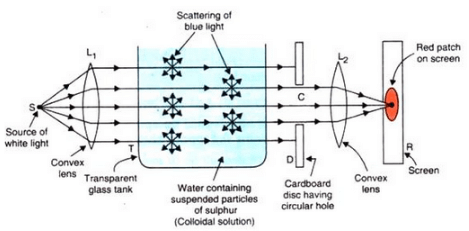
(b) Blue light scatters more easily due to its smaller wavelength
(c) Shortest wavelength component i.e. blue light scatters away when the sun appears red at sunrise or sunset,
(d) Gas moleccules present in the air.
Question 20: In an experiment to study the scattering of light by passing a beam of white light through a colloidal solution of sulphur in a transparent glass tank :
(a) Which colour is observed from the front of the glass tank ? Does this colour correspond to the colour of
sky on a clear day or the colour of sky around the sun at sunset ?
(b) Which colour is observed from the sides of the glass tank ? Does this colour correspond to the colour of
sky on a clear day or the colour of sky around the sun at sunset ?
Solution : (a) Red colour is observed from the front of the glass tank. This colour corresponds to the colour of sky around the sun at sunset.
(b) Blue colour is observed from the sides of the glass tank. This colour corresponds to the colour of sky on a clear day.
Question 21: Explain why, when the sun is overhead at noon, it appears white, but when the same sun is near the horizon at sunset, it appears red.
Solution : When the sun is overhead, then the light coming from the sun has to travel a relativity shorter distance through the atmosphere to reach us. During the shorter journey of sunlight, only a little of the blue color of the white light is scattered. Since light coming from the overhead sun has almost all its component colors in the right proportion, therefore the sun in the sky overhead appears white to us.
But when the same sun is near the horizon at sunset, the sunlight has to travel the greatest distance through the atmophere to reach us. During this long journey of sunlight, most of the shorter wavelength blue colour present in it is scattered out and away from our line of sight. So, the light reaching us directly from the setting sun consists mainly of longer wavelength red colour due to which the sun appears red.
Question 22: Complete the following statements :
When the sun is setting, the light from it has to travel a ……………… thickness of the earth’s atmosphere and only…….. wavelength……… light is able to reach us. Sunset is therefore……….
Solution : greater; longer; red; red
|
80 videos|569 docs|80 tests
|
FAQs on Lakhmir Singh & Manjit Kaur: The Human Eyes And The Colorful World, Solutions- 4 - Science Class 10
| 1. How does the human eye perceive different colors? |  |
| 2. Why do some people have different eye colors? |  |
| 3. Can the human eye see all colors? |  |
| 4. How do glasses or contact lenses help in correcting vision problems? |  |
| 5. Can the human eye see in the dark? |  |
















